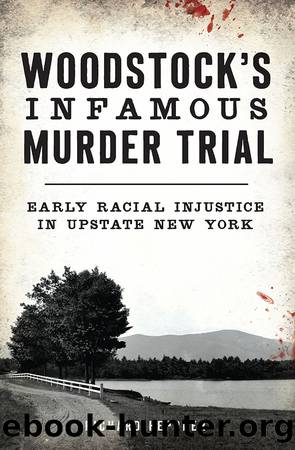Woodstock's Infamous Murder Trial by Heppner Richard R.;

Author:Heppner, Richard R.;
Language: eng
Format: epub
Publisher: Arcadia Publishing
Published: 2020-08-15T00:00:00+00:00
9
VAN GAASBEEK TAKES THE STAND
Though the hour on that Thursday afternoon grew late, it was time for Augustus Van Buren to offer a defense by putting his client before the jury. Prior to doing so, however, he addressed the twelve white men before him. Not quite secure how they might view the testimony of the defendant speaking to them from the witness stand, he reminded them that they were duty bound to listen to the testimony they were about to hear âwithout prejudice.â
With his client sworn in and seated on the stand, Van Buren was in no hurry to explore the events surrounding Harrisonâs death. Rather, in an effort to personalize Van Gaasbeekâs story, Van Buren took his client through a series of questions that revealed his basic life history, including employment. And, in the process, Van Buren hoped to establish his client as a religious person in the eyes of the jury.
Stating that he was fifty-four years old and would turn fifty-five on June 19 of that year, Van Gaasbeek told the court that he had been born in Woodstock, that his father had been deceased some twenty-eight years and that his mother had âbeen dead eight or nine years.â From there, he began establishing that he had long been a hard worker, finding employment whenever and wherever he could. Citing work that he undertook, primarily in Kingston, Van Gaasbeek ticked off the various jobs he held, beginning with a position as coachman and gardener for Mrs. Cornelius Bruyn, a position he held for eight years and one that only terminated with his employerâs death. He would go on to serve as a coachman yet again for a Mrs. Hester in Kingston, who, in 1903, was said to have purchased one of the finest teams of seal brown horses in Ulster County. Following a stint on an ice wagon for DeWitt Cunyes and F.S. Van Wagenen in Kingston, Van Gaasbeek sought work back in Woodstock, eventually catching on with a construction crew working the state road between Woodstock and Saugerties. Once that work was concluded, it became a matter of what odd jobs he could find around Woodstock.
As Van Buren began to approach his clientâs relationship with the younger Harrison, he did so in a way that he hoped would project positively on the jury. Asking Van Gaasbeek to tell jurors how long he had known Harrison and how they had come to meet each other, Van Gaasbeek responded that they had been friendly for three or four years and that he âused to come up to Woodstock to church and in that way I got acquainted with him.â
Not minimizing his relationship with the victim, Van Gaasbeek also related that one Sunday, while he was next door at the Conine home, Harrison arrived there. Mentioning that he was out of work, Harrison said he would like to stay with Van Gaasbeek for a while. That night, Van Gaasbeek told the jury, they went to church.
While Harrison stayed with Van
Download
This site does not store any files on its server. We only index and link to content provided by other sites. Please contact the content providers to delete copyright contents if any and email us, we'll remove relevant links or contents immediately.
The 1921 Tulsa Race Massacre by Chris M. Messer(239)
Introduction to Criminal Justice - A Balanced Approach by Brian K. Payne Willard M. Oliver Nancy E. Marion(226)
Russia's Sakhalin Penal Colony, 1849â1917 by Andrew A. Gentes(219)
The History of Newgate Prison by Jowett Caroline;(212)
Punishing the Poor The Neoliberal Government of Social Insecurity by Unknown(201)
A History of Police and Masculinities, 1700-2010 by David G. Barrie Susan Broomhall(173)
Serial Killers America and UK - 2 BOOKS IN 1 by Clark Matthew(166)
Restorative Justice in Transitional Settings by Kerry Clamp(137)
Culture, Crime and Punishment by Ronald Kramer(132)
Policing Gender, Class And Family In Britain, 1800-1945 by Linda Mahood(130)
Routledge Handbook on Immigration and Crime by Holly Ventura Miller Anthony Peguero(130)
Organized Crime and Corruption Across Borders by T. Wing Lo Dina Siegel Sharon I Kwok(129)
Cops, Cameras, and Crisis by Michael D. White Aili Malm(129)
Dangerousness, Risk and the Governance of Serious Sexual and Violent Offenders by Karen Harrison(126)
The Real CSI by Kate Bendelow(125)
Women Exiting Prison by Bree Carlton Marie Segrave(118)
A Theory of African American Offending by James D. Unnever Shaun L. Gabbidon(113)
Losing Legitimacy by Gary Lafree(113)
Using Murder by Philip Jenkins(110)
